
The Opticron Adventurer T WP 6.5 x 32.
A Work Commenced June 12 2022
Product: Opticron Adventurer T WP 6.5 x 32
Country of Manufacture: China
Chassis Material: Rubberised Aluminium & Polycarbonate
Exit Pupil: 4.9mm
Eye Relief: 18mm
Field of View: 161m@1000m(9.2 angular degrees)
Coatings: Fully Multicoated on all glass surfaces
Prisms: Porro BAK4
ED Glass: No
Close Focus: 3m advertised, 2.56m measured
Dioptre Compensation: +/- 4.0
Waterproof: Yes
Nitrogen Purged: No
Tripod Mountable: Yes
Accessories: tetherable rubber objective lens caps, ocular caps, padded neck strap, soft carrying case, microfibre lens cleaning cloth, warranty card & instruction manual.
Weight: 549g advertised, 556g measured
Warranty: 2 Years
Dimensions LxWxD (cm): 10.9 x 16.9 x 5.0
Price(UK): £65.21
Recently I put the Opticron Adventurer T WP 8 x 32 through its paces. This neat little porro prism binocular greatly exceeded my expectations, based on its excellent price to performance ratio. But I was keen also to test drive its lower power sibling, the Opticron Adventurer T WP 6.5 x 32. So I ordered up a unit from Amazon and spent a couple of weeks using it in a variety of environments. Since many of the basic features on both the 8 x 32 and the 6.5 x 32 are identical, it provided a good opportunity to investigate a phenomenon known as depth of field, and the factors which might govern its behaviour, which I shall elaborate on shortly. For now, I want to briefly summarise my findings of the 6.5 x 32 in relation to the 8x glass in the same series.

The Opticron Adventurer T WP 8 x 32 (top) compared with the 6.5 x 32 (bottom).
Like the 8 x 32 model, the 6.5x glass showed excellent control of internal reflections, diffused light and diffraction spikes(i.e. none seen). It was extremely clean, as judged by my Iphone 7 torch test.
Collimation was good as tested under the stars and also by checking a horizontal electricity cable in the distance.
Having a look at the exit pupils, I noted only slight truncation in the left barrel, but in general, the results were very good:
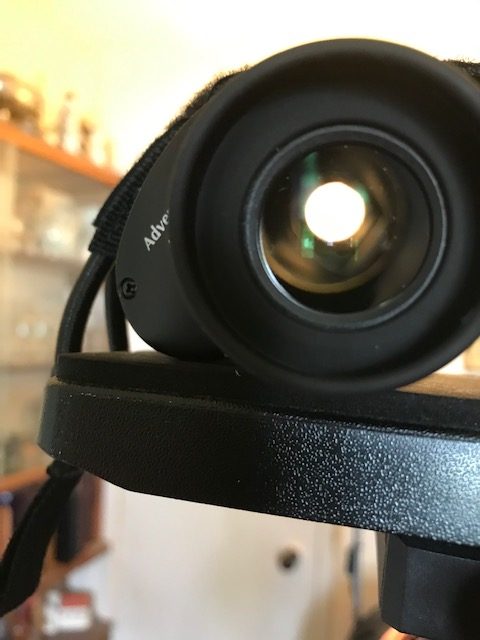
Left exit pupil shows slight truncation.
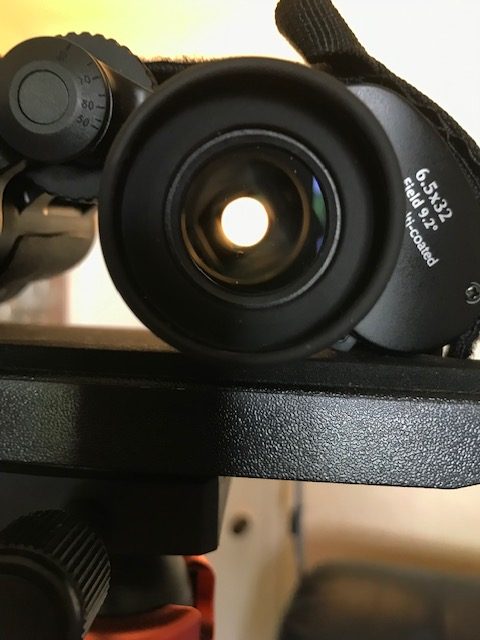
Right exit pupil shows nice circular geometry.
The first big surprise for me was its much superior glare suppression compared with the 8 x 32 model. For some reason that still escapes me, the 6.5x produced noticeably higher contrast images than its 8x sibling. I can only surmise that newer coatings were applied to these units at some point. Veiling glare was also much better controlled in the 6.5x unit. Eye relief is good: I was able to image the entire field with my glasses by rolling down the rubber eyecups, but it’s a fairly tight squeeze!
Close focus was measured at just over 2.5m, considerably better than the advertised 3m setting. The 6.5 x 32 delivers a huge field of view – fully 9.2 angular degrees! The sweet spot is quite large too, remaining very sharp in the inner 60 per cent or so of the field .After that, mild field curvature sets in, becoming progressively more severe as one approaches the field edges. To my eye, about 75 per cent of the field was acceptably sharp, with more pronounced blurring occurring in the last 25 per cent before hitting the field stops. Sometimes I would notice a ‘fish bowl’ effect while panning large swathes of landscape. The image is very bright; noticeably brighter than the 8x glass in fact, especially in low light conditions, at and after sunset. Colour correction is excellent in the centre, but does show a bit of lateral colour as the eyes are moved off axis, but it was no more than I’ve seen in instruments costing ten times its retail cost. In terms of colour balance, I judged the image as quite neutral.
The image through the Adventurer T WP 6.5 x 32 is very stable and quite immersive. I can easily understand why an instrument like this would be ideal for a younger individual or an older observer wishing to minimise image shake while glassing. For me though, I felt the 6.5x lacked those little details I’ve come to pick up more easily in 8x and 10x instruments. In other words, it lacked a little bit of reach. But that’s an entirely personal judgement and your mileage may vary.
Depth of Field & Stereoptic Comparisons Between the 8 x 32 and 6.5 x 32 Models
Comparing the two instruments on an open landscape in bright sunlight, I judged the image plasticity(3D effect) to be noticeably more pronounced in the 8x model. This was in keeping with my previous study on stereopsis which can be seen in this link. Indeed, the only two factors which influence image plasticity are the IPD, the separation between the objectives and the magnification, increasing linearly as these variables increase.
The opposite was true when I made some depth of field measurements, that is, when focused at infinity, how close could I keep an object focused sharply in the foreground. Borrowing my son’s laser rangefinder, and being careful to only image objects in the centre of the field to avoid the spurious effects of field curvature creeping in at the bottom of the field(which gives the impression of tightening up the focus at closer ranges), I measured the close focus at infinity of the 6.5x glass to be 33.9 yards, while that of the 8x glass gave a result of 44 yards.
So depth of field increases as magnification decreases. The question remains though, how does magnification scale with this phenomenon? To what power? And do any other factors determine the outcome?
It would be nice to know.
This is a rather complex and interesting question for sure, but I did find a reliable source that could give me a head start. Way back in 2004, a German professor of computational physics, Dr Holger Merlitz, based at the Leibniz Institute for Polymer Research, Dresden, posted an interesting communication in Cloudynights Binocular forum, where he adopted a very interesting quantitative approach to this question. I will quote the relevant part here for interest:
Hello Jean-Charles,
Your results on DOF for a binocular is in agreement with whatever I was able to figure out so far. In fact, magnification and (effective) exit pupil appear to be the dominating parameters. Here, ‘effective’ means the smaller of both, the observer’s eye-pupils and the exit pupil. I must admit that not all aspects are clear to me. The following approach to analyse this problem was suggested by Walter E. Schoen on a German discussion board:
The thin-lens equation
1/F = 1/G + 1/B
relates the distance of the object to be observed (G) with the focal length (F) and the distance of its image (B). A telescope is essentially made of two lenses, and the above relation is valid for both of them, the objective, and the ocular, for which we shall write
1/f = 1/b + 1/g
Now we assume that the binocular is focused to infinity. This means that the ocular is positioned in a way that the focal plane of the objective is on top of the focal plane of the ocular. Each object with large distance produces a sharp image in this particular plane, and the image ‘B’ of the objective coincides with the object ‘g’ of the ocular. Now we assume the object is coming closer. Its image ‘B’ is therefore shifting away from this plane, and since we keep the telescope focused on infinity, the ocular’s image ‘b’ of the ‘object ‘B’ becomes unsharp. One approach is to calculate the distance, to which the eye has to focus in order to get this image ‘b’ back into focus. The reciprocal value of this distance is the diopter-value the eye has to accommodate. With some arithmetic, and using V = F/f (magnification) and f+F = g+B = distance between objective and ocular one can obtain
b = G/Vˆ2 – f – f/V
(actually, when I tried to verify this relation, I got the opposite sign, but, being no professional, I may have messed up some conventions used for optical computations).
The result he got seemed to suggest that the main factor determining depth of field is indeed magnification. However, Dr Merlitz didn’t flesh out the details of how he arrived at this result.
Trust but verify.
So I had a go this afternoon and was able to derive the same formula, the details of which are reproduced below in my own handwriting:

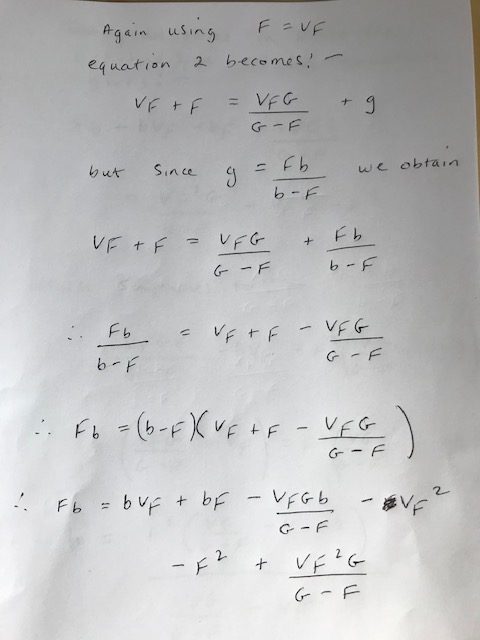
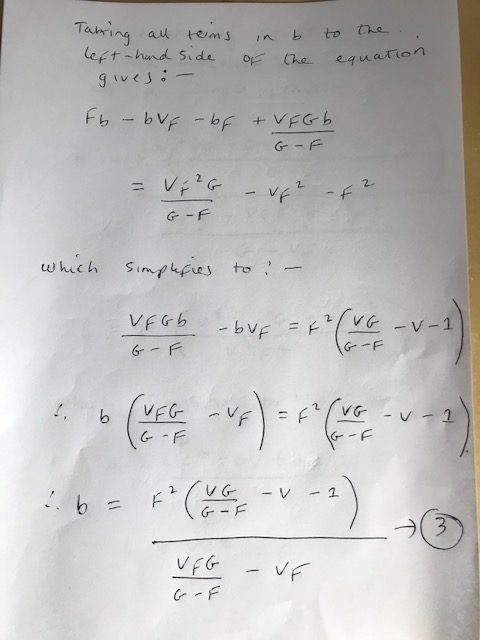
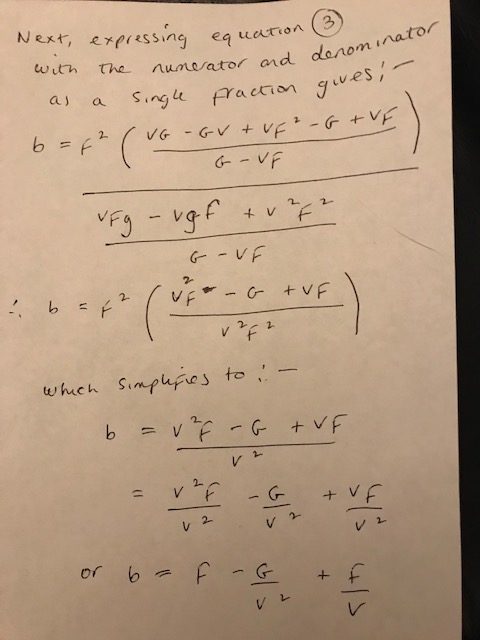
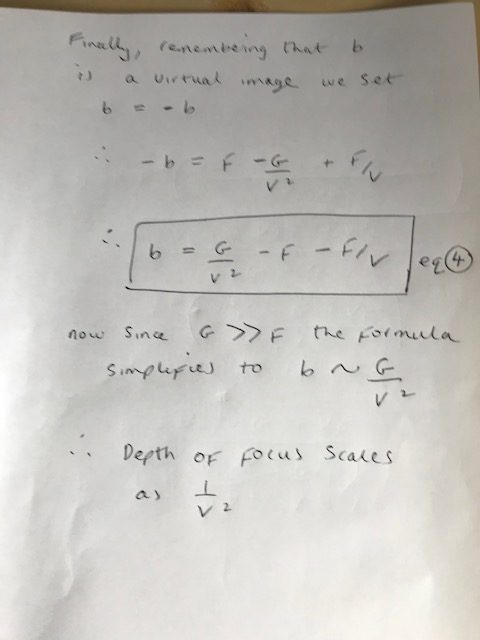
So the result appears to indicate that depth of field in binoculars scales as 1/v^2, and this appears to be the predominant factor determining this effect. Incidentally, it also agrees with the findings in an article published on binoculars on Wikipedia, though no reference is given, and I always take such sources with a pinch of salt:
With increasing magnification the depth of field – the distance between the nearest and the farthest objects that are in acceptably sharp focus in an image – decreases. The depth of field reduces quadratic with the magnification, so compared to 7× binoculars, 10× binoculars offer about half (7² ÷ 10² = 0.49) the depth of field. However, not related to the binoculars optical system, the user perceived practical depth of field or depth of acceptable view performance is also dependent on the accommodation ability (accommodation ability varies from person to person and decreases significantly with age) and light conditions dependent effective pupil size or diameter of the user’s eyes.
Thus, the increase in the depth of field of the 6.5x glass compared with the 8x instrument should be about 8^2/6.5^2 or 1.51. Comparing this result to the numbers I measured, I get 44^2/33.9^2 = 1.68.
Not bad at all!
Of course, other inter-individual factors may also contribute to greater or less perceived depth of field, when two different binoculars of the same magnification are employed, such as accommodation, field curvature, or the size of the exit pupil etc.
Conclusions & Recommendations
The Opticron Adventurer T WP 6.5 x 32 is an excellent bargain for the rock bottom price paid. In keeping with the results reported by the reviewer showcased in the preamble above, it performs very well indeed, and should delight the owner with sharp, contrast-rich details in a very impressive and immersive field of view. Its minimum IPD of 53mm will make it especially attractive to those who have smaller faces, and the ultra-stable views at 6.5x will likely delight individuals who suffer from significant handshake.
Highly Recommended!
Dr Neil English is the author of seven books in amateur and professional astronomy. His 8th title, Choosing Binoculars: A Guide for Stargazers, Birders and Outdoor Enthusiasts, will be published sometime in late 2023 by Springer Nature.
Hi Neil. I am tossing up between this binocular and the Nikon 7×35 action ex. Do you have a favourite here?
Hello Doug,
Nice to hear from you again.
I’ve only tested the Opticron model and not the Nikon, so I can’t answer precisely. It has excellent central sharpness but does exhibit field curvature in the outer field.
However, the Nikon appears to be better armoured and is waterproof and fogproof. The Opticron is simply waterproof, at least in theory. The Nikon is about 60 per cent heavier.
The Opticron is significantly cheaper but that shouldn’t be an absolute indicator of inferiority. The Opticrons offer tremendous bang for buck though.
That’s all I can say I’m afraid.
Best wishes,
Neil.
Just one more detail. Did they have sharp field stops or fuzzy.
Hi Neil and Doug,
I have owned and used (extensively) the nikon ex 7×35, and I own and love the opticron adventurer t wp 6.5×32. I use binos in my pursuit of wildlife photography, so they tend to have a harder life than those used by birders and astronomers (small knocks and bumps, sand, soil and leaf litter are daily hazards). the nikon is heavier, more robust, more waterproof (mine was washed under slow running water on several occasions after days at the beach). The opticron is lightly built, and in my use, it has suffered, but I love the views it gives and it is a far more enjoyable binocular than the nikon.
Pros:
– bright, crisp and contrasty; sharp to the edge if you re-focus
– no chromatic aberration in the centre, (there is some at the edge, but I’m fussy about CA and I never notice any in actual use)
– large depth of field and field curvature combine to give wonderfully deep immersive views;
– focuser and diopter are relatively easy and smooth (compared to the nikon)
– small and lightweight and easy to hold steady. The short wide form factor and lower magnification contribute to this.
– ridiculously low purchase price
Cons:
– weather proofing is really for light rain, and I recommend buying a rain guard to stop water pooling on the objectives. Mine got water inside after several hours use in heavy rain.
– build quality – it may look similar to a nikon e ii, but it isn’t one, (and to be fair, it is a fraction of the price). be careful with the eye cups if you have to fold them down, as they can pop off fairly easily (catching on a sweater for example). I have solved this by wrapping velcro cable ties around the base of the eye cups , which works and looks tidier than using tape.
Summary: I love the opticron 6.5×32; it’s provides such an enjoyable view. The nikon is more robust, but the view is less bright (verging on dark), less clear, less crisp (causing you to fiddle with focus) and the waterproofing make the focuser sticky.
Hello Clive,
Thanks very much for your message and most excellent overview of both the Opticron and Nikon binoculars.
I think you’ve answered Doug’s question for me!
And I agree: the Opticron is a sweet little Porro and delivers great bang for buck.
Best wishes,
Neil.
Thank you gentlemen. I actually tried to purchase the Opticron, but i found it was only available here in Australia via a seller on Amazon. That site required my card details left there, so I backed away from purchase. That left a local purchase of the Nikon Action Extreme 7×35, which is now on its way. Where I live is 550 metres altitude in sub tropical Queensland, and in wet weather we are literally in the clouds. Weather and fog proofing would be an advantage. Regards.
The Opticron seller was in England. If there was a problem with purchase, the distance would only add difficulties.
Hi Douglas,
It’s more money, but the Kowa BD XD ii 6.5×32 roof prism binocular is also very nice. I tried it alongside my opticron, as it is properly weather sealed. In the end I couldn’t justify spending the money when the opticron’s only weakness for me is build. I would say that the Kowa’s view is significantly better than the nikon ex. For my use in close woodland, I prefer the opticron, by a whisker, but the kowa does close focus views beautifully, (this is a weak point for porros as you probably know).
Food for thought anyway – if the Kowa is in your price range – you could order both, keep the one you prefer and return the other.
Best regards,
Clive
The Nikon 7×35 Action ex came today. Quite delighted with them. 3D effect as well as depth of field is most noticeable over other binoculars I have tried. Wide field, sharp field stops, good enough for me.
Thank You gentlemen.
Douglas.
Hello Douglas,
That’s good to hear. I hope it gives you many years of service.
With best wishes,
Neil.
Hello Neil,
Thanks for the review. I’ve had experience of Opticron porros and have always been impressed. Recently I bought a Vega II 8×40 from ebay which had seen better days and needed some work. I was surprised to find that it was delivering daytime views as good as my Svbony 8×32 which I bought on your recommendation. I also bought the small Helios 2x binocular. Both of these have not disappointed, and so I’d like to know if you tried the Opticron 6.5s under the stars and what your thoughts were. I’m always looking for those wide immersive views.
Cheers,
Martyn.
Dear Martyn,
Many thanks for your feedback.
Good to hear you got a bargain from the Vega II. I’ve personally not tested this model but being a classic Porro, I’m sure it delivers very fine views.
Regarding the Opticron Adventurer T WP 6.5 x 32, I’ve not done much testing of it under the night sky. Personally, I prefer higher magnifications when doing astronomy – usually 10x. I find lower powers fail to darken the sky sufficiently even if it’s offset by having a wider field of view. That said, there is an army of folk who love using it because it’s so light weight and handy to carry about.
With best wishes,
Neil.
I eventually ended up buying the T WP 6.5x 32 from Amazon Australia. It was selling for almost half the usual price. It also arrived in a couple of days, strange , as the 8x model i bought took nearly two weeks to arrive from England. On arrival the box containing the binocular was markedly damaged. I thought this probably explains the low price and was concerned about having to return them if damaged. But on removing the binocular, all looked well. I must say Niel, your appraisal of this binocular is spot on. I found it was superior to the 8x model as your review clearly shows. Such amazing performance for so little money. Thanks for your help, and your book is on my gift list.
Hi Douglas,
Very glad to hear your findings on the 6.5 x 32. It’s a nice little performer.
Thanks for the feedback!
Regards,
Neil